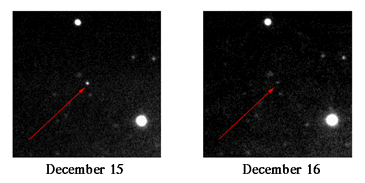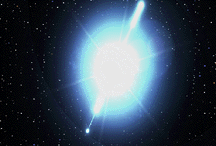Most Powerful Explosion Since Big Bang
Astronomers Detect Most Powerful Explosion Since Big Bang
| 18 May 1998 |
The energy released in a cosmic gamma-ray burst detected in December 1997 is the most energy ever detected from an explosion in the Universe, perhaps making it the most powerful explosion since the creation of the Universe in the Big Bang.
"For about one or two seconds, this burst was as luminous as all the rest of the entire Universe," said Caltech professor George Djorgovski, one of the two principal investigators on the team from the California Institute of Technology, Pasadena, CA.
The burst was detected on Dec. 14, 1997, by the Italian/Dutch BeppoSAX satellite and NASA's Compton Gamma-Ray Observatory satellite. The Compton observatory provided detailed measurements of the total brightness of the burst, designated GRB 971214, while BeppoSAX provided its precise location, enabling follow-up observations with ground-based telescopes and NASA's Hubble Space Telescope.
"The energy released by this burst in its first few seconds staggers the imagination," said Caltech professor Shrinivas Kulkarni, the other principal investigator on the team.
The burst appears to have released several hundred times more energy than an exploding star called a supernova, which until now was the most energetic known phenomenon in the Universe. Finding such a large energy release over such a brief period of time is unprecedented in astronomy, except for the Big Bang itself.
"In a region about a hundred miles across, the burst created conditions like those in the early Universe, about one milli second (1/1,000 of a second) after the Big Bang," said Djorgovski.
This large amount of energy was a surprise to astronomers. "Most of the theoretical models proposed to explain these bursts cannot explain this much energy," said Kulkarni. "However, there are recent models, involving rotating black holes, which can work. On the other hand, this is such an extreme phenomenon that it is possible we are dealing with something completely unanticipated and even more exotic."
Gamma-ray bursts are mysterious flashes of high-energy radiation that appear from random directions in space and typically last a few seconds. They were first discovered by U.S. Air Force Vela satellites in the 1960s. Since then, numerous theories of their origin have been proposed, but the causes of gamma-ray bursts remain unknown. The Compton Observatory has detected several thousand bursts so far.
The principal limitation in understanding the bursts was the difficulty in pinpointing their direction on the sky. Unlike visible light, gamma-rays are exceedingly difficult to observe with a telescope, and the bursts' short durations exacerbate the problem. With BeppoSAX, scientists now have a tool to localize the bursts on the celestial sphere with sufficient precision to permit follow-up observations with the world's most powerful ground-based telescopes.
This breakthrough led to the discovery of long-lived "afterglows" of bursts in X-rays, visible and infrared light, and radio waves. While gamma-ray bursts last only a few seconds, their afterglows can be studied for several months. Study of the afterglows indicated that the bursts do not originate within our own Milky Way Galaxy, but rather are associated with extremely distant galaxies. The faint galaxy from which GRB 971214 originated is estimated to be about 12 billion light years from the Earth. The galaxy is about as faint as an ordinary 100 watt light bulb would be as seen from a distance of a million miles.

The cause of the observed explosion is unknown. Scientists have several models, such as a neutron star falling into a black hole (see the movie below) or two black holes colliding, which may account for such an explosion. However, only future, better observations will permit researchers to choose among competing theories for the origin of gamma-ray bursts.

|
A neutron star falling into a black hole! |

